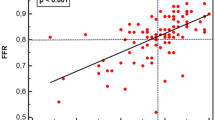Abstract
Purpose
Maximal graft flow acceleration (max df/dt) determined using transit-time flowmetry (TTFM) in the diastolic phase was assessed as a potential predictor of graft failure for aortocoronary artery (AC) bypass grafts in coronary artery bypass patients.
Methods
Max df/dt was retrospectively measured in 114 aortocoronary artery bypass grafts. TTFM data were fitted to a 9-polynomial curve, which was derived from the first-derivative curve, to measure max df/dt (9-polynomial max df/dt). Abnormal TTFM was defined as a mean flow of <15 ml/min, a pulsatility index of >5 or a diastolic filling ratio of <50 %. Postoperative assessments were routinely performed by coronary artery angiography (CAG) at 1 year after surgery.
Results
Using TTFM, 68 grafts were normal, 4 of which were failing on CAG, and 46 grafts were abnormal, 21 of which were failing on CAG. 9-polynomial max df/dt was significantly lower in abnormal TTFM/failing by the CAG group compared with abnormal TTFM/patent by the CAG group (1.08 ± 0.89 vs. 2.05 ± 1.51 ml/s2, respectively; P < 0.01, Mann–Whitney U test, Holm adjustment).
Conclusions
TTFM 9-polynomial max df/dt in the early diastolic phase may be a promising predictor of future graft failure for AC bypass grafts, particularly in abnormal TTFM grafts.



Similar content being viewed by others
References
Cerrito PB, Koenig SC, Van Himbergen DJ, Jaber SF, Ewert DL, Spence PA. Neural network pattern recognition analysis of graft flow characteristics improves intraoperative anastomotic error detection in minimally invasive CABG. Eur J Cardiothorac Surg. 1999;16:88–93.
D’Ancona G, Karamanoukian HL, Ricci M, Schmid S, Bergsland J, Salerno TA. Graft revision after transit time flow measurement in off-pump coronary artery bypass grafting. Eur J Cardiothorac Surg. 2000;17:287–93.
Kieser TM, Rose S, Kowalewski R, Belenkie I. Transit-time flow predicts outcomes in coronary artery bypass graft patients: a series of, 1000 consecutive arterial grafts. Eur J Cardiothorac Surg. 2010;38:155–62.
Hiramatsu O, Goto M, Yada T, Kimura A, Chiba Y, Tachibana H, et al. In vivo observations of the intramural arterioles and venules in beating canine hearts. J Physiol. 1998;509:619–28.
Handa T, Orihashi K, Nishimori H, Fukutomi T, Yamamoto M, Kondo N, et al. Maximal blood flow acceleration analysis in the early diastolic phase for in situ internal thoracic artery bypass grafts: a new transit-time flow measurement predictor of graft failure following coronary artery bypass grafting. Interact Cardiovasc Thorac Surg. 2015;20:449–57.
Handa T, Katare RG, Sasaguri S, Sato T. Preliminary experience for the evaluation of the intraoperative graft patency with real color charge-coupled device camera system: an advanced device for simultaneous capturing of color and near-infrared images during coronary artery bypass graft. Interact Cardiovasc Thorac Surg. 2009;9:150–4.
Handa T, Katare RG, Nishimori H, Wariishi S, Fukutomi T, Yamamoto M, et al. New device for intraoperative graft assessment: HyperEye charge-coupled device camera system. Gen Thorac Cardiovasc Surg. 2010;58:68–77.
Ishikawa N, Watanabe G. Ultra-minimally invasive cardiac surgery: robotic surgery and awake CABG. Surg Today. 2015;45:1–7.
Kim KB, Kang CH, Lim C. Prediction of graft flow impairment by intraoperative transit time flow measurement in off-pump coronary artery bypass using arterial grafts. Ann Thorac Surg. 2005;80:594–8.
Di Giammarco G, Pano M, Cirmeni S, Pelini P, Vitolla G, Di Mauro M. Predictive value of intraoperative transit-time flow measurement for short-term graft patency in coronary surgery. J Thorac Cardiovasc Surg. 2006;132:468–74.
Lehnert P, Møller CH, Damgaard S, Gerds TA, Steinbrüchel DA. Transit-time flow measurement as a predictor of coronary bypass graft failure at one year angiographic follow-up. J Card Surg. 2015;30:47–52.
Walker PF, Daniel WT, Moss E, Thourani VH, Kilgo P, Liberman HA, et al. The accuracy of transit time flow measurement in predicting graft patency after coronary artery bypass grafting. Innovations (Phila). 2013;8:416–9.
Taggart DP, Choudhary B, Anastasiadis K, Abu-Omar Y, Balacumaraswami L, Pigott DW. Preliminary experience with a novel intraoperative fluorescence imaging technique to evaluate the patency of bypass grafts in total arterial revascularization. Ann Thorac Surg. 2003;75:870–3.
Balacumaraswami L, Taggart DP. Intraoperative imaging techniques to assess coronary artery bypass graft patency. Ann Thorac Surg. 2007;83:2251–7.
Takahashi M, Ishikawa T, Higashidani K, Katoh H. SPY: an innovative intra-operative imaging system to evaluate graft patency during off-pump coronary artery bypass grafting. Interact Cardiovasc Thorac Surg. 2004;3:479–83.
Waseda K, Ako J, Hasegawa T, Shimada Y, Ikeno F, Ishikawa T, et al. Intraoperative fluorescence imaging system for on-site assessment of off-pump coronary artery bypass graft. JACC Cardiovasc Imaging. 2009;2:604–12.
Budde RP, Bakker PF, Gründeman PF, Borst C. High-frequency epicardial ultrasound: review of a multipurpose intraoperative tool for coronary surgery. Surg Endosc. 2009;23:467–76.
Yamamoto M, Orihashi K, Nishimori H, Handa T, Kondo N, Fukutomi T, et al. Efficacy of intraoperative HyperEye Medical System angiography for coronary artery bypass grafting. Surg Today. 2015;45:966–72.
Di Giammarco G, Canosa C, Foschi M, Rabozzi R, Marinelli D, Masuyama S, et al. Intraoperative graft verification in coronary surgery: increased diagnostic accuracy adding high-resolution epicardial ultrasonography to transit-time flow measurement. Eur J Cardiothorac Surg. 2014;45:41–5.
Une D, Deb S, Chikazawa G, Kommaraju K, Tsuneyoshi H, Karkhanis R, et al. Cut-off values for transit time flowmetry: are the revision criteria appropriate? J Card Surg. 2013;28:3–7.
Author information
Authors and Affiliations
Corresponding author
Ethics declarations
Conflict of interest
None of the authors have any conflicts of interest related to this study.
Rights and permissions
About this article
Cite this article
Handa, T., Orihashi, K., Nishimori, H. et al. Maximal blood flow acceleration analysis in the early diastolic phase for aortocoronary artery bypass grafts: a new transit-time flow measurement predictor of graft failure following coronary artery bypass grafting. Surg Today 46, 1325–1333 (2016). https://doi.org/10.1007/s00595-016-1325-5
Received:
Accepted:
Published:
Issue Date:
DOI: https://doi.org/10.1007/s00595-016-1325-5




